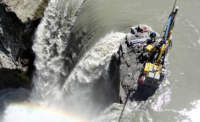Back when he was a young engineer, Glenn Tarbox wasn’t very interested in dams. He only took a job with the U.S. Bureau of Reclamation upon graduating from the University of Maryland in 1961 because they paid to move his wife and two young daughters all the way to Utah. It was much closer to California, where he hoped to work in the bridge division of the state’s Dept. of Highways once he saved up enough money to make the move.
But before Tarbox made a shift to bridges, he started work on Utah’s more than 500-ft-tall Flaming Gorge arch dam, an experience that changed him, he says. He “fell in love with dams,” and after 20 years with the bureau and 55 years working on concrete dams, Tarbox, 76, hasn’t lost a bit of that love.
Tarbox’s career included leading technological advancements at every stage of his career, specifically in the world of concrete dams. He led the trial-load analysis method for arch dams. He also was integral in designing double curvature arch dams in the Southwest and spearheading the move into large roller-concrete compacted dams while also mentoring young engineers and leading the entire industry from his perch atop consulting groups and private-sector divisions.
Tarbox has led groups at R.W. Beck, Harza, Bechtel and, most recently, MWH Global, now part of Stantec. His engineering scope quickly surpassed the 17-state reclamation territory and turned global, with a particular focus on China, where roller-concrete compacted dams have now surpassed 1,000 ft high. He credits this move for allowing him to remain involved in the business of designing concrete dams, whether Swan Lake in Alaska, Chinese projects or one of the 75 countries he has worked in.
“If you look around the world and have a company strong in that field, you can keep a flow of major projects that are interesting to engineers,” he says. And staying interested remained a key component for Tarbox, who was always “working with new ideas, working with research and being part of new schemes.”
Spearheading the move to the latest technology of his day, he went from hand calculations in the field to helping design computer programs for analysis. He also worked in the academic world, having written more than 70 papers. Tarbox says he found a perfectly suited career that brought him personal satisfaction while putting a focus on quality work.
“I love seeing designs come off paper and become reality in three dimensions in the field,” he says. “I love working with young people, mentoring them and seeing them develop. There are many elements that keep me excited about (the work).”
Michael Rogers, MWH vice president and global dams practice leader, met Tarbox in 1989 and they first worked together on a job in Egypt before Tarbox really started mentoring the junior engineer when they worked on Olivenhain Dam in San Diego, spending all week together before both commuted back home for the weekend.
“Glenn takes his work very personally,” Rogers says, “and he looks after his structures and has care for them almost like children. These projects are more than just cold concrete structures, they are actually important and the function of the projects are important. It has been really cool as I’ve been able to see that and how he is always looking at what is the right way and most current way to make these projects the best they can be for the owners and the people they protect. It has stayed with me.”
Rogers says Tarbox always shares knowledge with those around him—a knowledge dam owners appreciate. Jerry Reed, director of engineering for the San Diego County Water Authority, worked with Tarbox on the San Vicente Dam and the Olivenhain Dam, a 318-ft-tall structure that was the first roller-concrete compacted dam permitted in California and the tallest of its kind built in North America at the time. Reed says Tarbox was instrumental in getting the project approved.
“Glenn was a good leader for that design team,” Reed says. “He is not afraid to tell people when they are wrong or why they are right and then get on board. He definitely brings a background of knowledge, and there are not a lot of people left who built dams in the U.S. like he has, but I also believe he was a good mentor to the folks he worked with.”
Tarbox sees his work as helping people, whether to protect a reserve of water for the folks in San Diego or to change someone’s world. “A lot of people don’t like dams because of what they hear, but when you see vast areas of the face of the earth become irrigated and people are able to grow crops and not have to scrabble out of the ground and electrical power is generated and people no longer live by candles or oil lamps and women don’t have to walk miles with clay pots on their head and herd goats and sheep to a watering hole, but have a community well less than a kilometer from where they live,” he says, “that is northern Ethiopia. That is a real life experience I had on the Tekeze Dam.”
Even now, Tarbox remains eager to move the industry forward, saying the next big challenge includes earthquake engineering and dynamic analysis, including producing analytical software to predict dam behavior. “That is a frontier that is right now very much in hand,” he says.
And as has been his way for the past 55 years, expect Tarbox to lead the charge and mentor others along the way.




